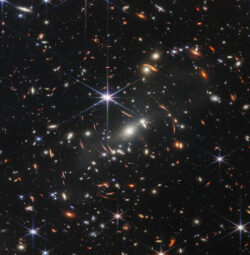
By Cori Zaragoza, V&V Staff Writer
NASA began working on the James Webb Space Telescope, then called the Next Generation Space Telescope, in 1996, with the hope that the project would be ready for launch in 2007. That was wishful thinking.
By 2018, over ten years since its initial projected launch date, the project was still not ready to launch, according to a July article by the New York Times (NYT). Despite the pieces and parts of the telescope being ready, the piece of technology had yet to be assembled and tested. The project, which had accrued the cost of close to $8 billion dollars, was in the hot seat with Congress, who had already supplied major funding. The Webb Telescope was meant to be revolutionary; it would study every aspect of cosmic history – from our solar system to distant galaxies. That was the plan, if NASA could get it to work.
There to put the pieces together and solve the puzzle was one man, Mr. Gregory Robinson, who was asked to become the program director of the Webb Telescope after his decades of work in NASA. Robinson, who previously held the position of deputy associate administrator for programs at NASA, would go on to assess the performance of over 100 science missions and save the Webb project from failure.
Robinson’s story is aspirational; at 62 years of age, he is one of the few Black executives in the top levels at NASA.
“Certainly people seeing me in this role is an inspiration,” he said to the NYT, “and also it’s acknowledging they can be there, too.”
The NYT states that Robinson was born in Danville, Virginia, the ninth out of 11 children born to tobacco sharecroppers. He was made to attend a segregated school for Black children until the school district integrated in 1970, when he was in the fifth grade.
Through a football scholarship at the Virginia Union University in Richmond, Robinson pursued science and math, later transferring to Howard University. Eventually, he earned a bachelor’s in electrical engineering from Howard and a bachelor’s in math from Virginia Union.
When Robinson took over the Webb Telescope, he discovered a plethora of problems. After his initial inspection, NASA pushed the launch date to March 2021, and needed an additional $800 million in funds, according to the NYT, showing how badly the telescope needed to be fixed. He quickly assembled a team to assess the project, eventually releasing a list of 32 recommendations for the telescope, all of which were implemented by NASA.
The schedule efficiency for the telescope was 55 percent before Robinson took the lead, but within a few months, he was able to get that efficiency to 95 percent. The pandemic slowed down the work, but the telescope was eventually launched on Christmas day in 2021, as reported by the NYT.

Months later, the Webb Space Telescope sent back its first photos. The first color photos of space ever taken were released on Tuesday, July 11, by NASA, showing far-off stars at the edge of our solar system. The world was entranced by the swirls of the cosmo; bathed in bright blue and orange.
Through the Webb Telescope, we are able to see places that humans can only dream of reaching, all thanks to Gregory Robinson. His contribution has not been overlooked; he was named as one of the most influential people in the world in the TIME100, TIME magazine’s annual list of the 100 most influential leaders.
“I’ve had an enriching career with great colleagues, and I am so proud to be a part of this first chapter in Webb’s science story, with a team that has shown exemplary steadfastness after years of work on the program,” said Robinson in a press release by NASA. “Webb will begin a consequential science journey, and to see that we are getting so close to unfolding the universe at long last is mind-blowing.”


